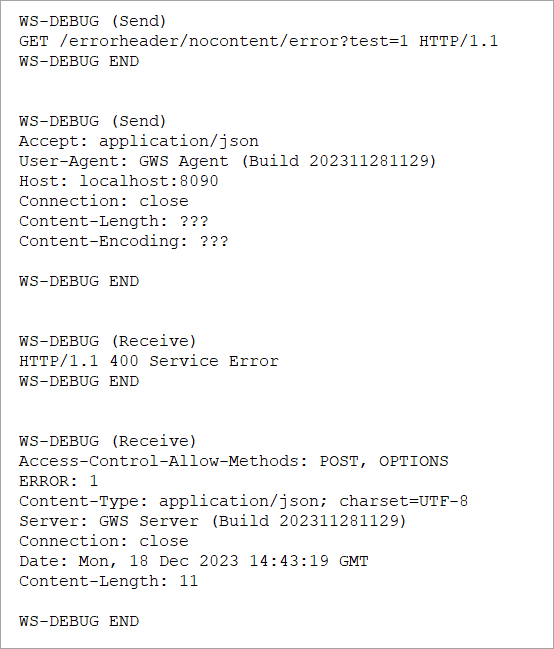WSErrorHeader
Defines custom headers in the error response of web service functions.
Syntax
WSErrorHeader= "{ code } [,...]"- code defines a comma-separated list of HTTP status error codes may be returned when the GWS server generates a response with an error code. Codes between 400 to 599 represent HTTP error responses.
WSErrorHeader is an optional attribute.
Usage
You use this attribute in a REST web service function to dynamically return a HTTP error code in a header instead of the body when the GWS server generates a response with an error code. By default, the REST operation returns HTTP status codes in the body, but this method allows you to set the return code in a custom header.
The following are conditions of use:
- You must use
WSErrorHeaderon a return parameter only; otherwise, error -9143 is thrown. - You must use
WSErrorHeaderin conjunction with WSThrows. TheWSErrorHeaderattribute requires theWSThrowsattribute in your function; otherwise, error -9145 is thrown. - You must use
WSErrorHeaderwithWSThrowsas follows:- Specify
WSErrorHeaderwithout an error code value to send a header for all values present inWSThrows. - Specify
WSErrorHeaderwith one or more error code values present inWSThrowsto send a header for only those values.
WSThrows; otherwise, error -9146 is thrown. - Specify
You can also use
WSErrorHeader in conjunction with the WSHeader attribute. For example:- You define
WSHeaderto send a custom header when the status is a success (codes between 200 to 399) - Whereas you define the
WSErrorHeaderto send a custom header when the status is an error code (codes between 400 to 599).
This example illustrates how you may use WSHeader on its own and together with
WSErrorHeader:
# ...
RETURNS(STRING ATTRIBUTE (WSHeader, WSName = "X-Header-Token"),
STRING ATTRIBUTE(WSHeader,WSErrorHeader = "400", WSName = "Access-Control-Allow-Methods"))
# ...- The header "
X-Header-Token" will only be returned when the status code indicates a success. The header will not be returned in the case of a response with error 400. - The "
Access-Control-Allow-Methods" header will be returned in the case of a 200 response and also if the response is 400.
In your function, you code to trap an error at runtime with a call to the SetRestError() method, to return the HTTP status code and a description to the client.
Example WSErrorHeader content error
In this sample
REST function status codes are returned in headers. The
WSThrows attribute is set
to handle errors that may be encountered. It has options to respond to two HTTP errors:- Error 400 when the resource is not found
- Error 401 when access is unauthorized
test input parameter is checked. Depending on the value, an error is
thrown and returned in the response with an error description provided in the
WSError attributed variable referenced in @myError in
WSThrows. Response headers are sent depending on the generated status code:
A call to SetRestError()
returns the error message in the specified header. - The "
Access-Control-Allow-Methods" header is set for bothWSHeaderandWSErrorHeader; the header will be returned in the case of both a 200 response and also if the response is 400. - The
"Access-Control-Allow-Origin"header set forWSHeaderis sent in the case of a 200 response. - The "
ERROR" header set forWSErrorHeaderis sent if the response is 400 or 401.
PUBLIC DEFINE myError RECORD ATTRIBUTE(WSError = "Service Error")
code INTEGER,
message STRING
END RECORD
PUBLIC FUNCTION test_NoContentError(
test INTEGER ATTRIBUTE(WSQuery))
ATTRIBUTE(WSGet,
WSPath = "/nocontent/error",
WSDescription = "test with WSErrorHeader (return 400)",
WSThrows = "400:@myError,401")
RETURNS(STRING ATTRIBUTE(WSHeader,
WSErrorHeader = "400",
WSName = "Access-Control-Allow-Methods"),
STRING ATTRIBUTE(WSHeader, WSName = "Access-Control-Allow-Origin"),
INTEGER ATTRIBUTE(WSErrorHeader,
WSDescription = "in case error",
WSName = "ERROR"))
DEFINE method, origin STRING
DEFINE err INTEGER
LET method = "POST, OPTIONS"
LET origin = "*"
IF test = 1 THEN
LET err = 1
CALL com.WebServiceEngine.SetRestError(400, myError)
ELSE
CALL com.WebServiceEngine.SetRestError(401, myError)
END IF
RETURN method, origin, err
END FUNCTION